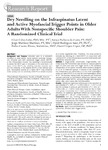Mostrar o rexistro simple do ítem
Dry Needling on the Infraspinatus Latent and Active Myofascial Trigger Points in Older Adults With Nonspecific Shoulder Pain: A Randomized Clinical Trial
| dc.contributor.author | López-López, Daniel | |
| dc.contributor.author | Calvo-Lobo, César | |
| dc.contributor.author | Pacheco-da-Costa, Soraya | |
| dc.contributor.author | Martínez-Martínez, Jorge | |
| dc.contributor.author | Rodríguez Sanz, David | |
| dc.contributor.author | Cuesta-Álvaro, Pedro | |
| dc.date.accessioned | 2022-03-09T11:21:49Z | |
| dc.date.available | 2022-03-09T11:21:49Z | |
| dc.date.issued | 2018 | |
| dc.identifier.citation | Calvo-Lobo C, Pacheco-da-Costa S, Martínez-Martínez J, Rodríguez-Sanz D, Cuesta-Álvaro P, López-López D. Dry Needling on the Infraspinatus Latent and Active Myofascial Trigger Points in Older Adults With Nonspecific Shoulder Pain: A Randomized Clinical Trial. J Geriatr Phys Ther. 2018 Jan/Mar;41(1):1-13. doi: 10.1519/JPT.0000000000000079. PMID: 26760574; PMCID: PMC5728593. | es_ES |
| dc.identifier.uri | http://hdl.handle.net/2183/29922 | |
| dc.description.abstract | [Abstract] Background and purpose: Shoulder pain is a prevalent condition in older adults. Some authors associate nonspecific shoulder pain with myofascial trigger points (MTrPs) in the infraspinatus muscle. Dry needling is recommended to relieve the MTrP pain of shoulders in the short term (<9 days). Active MTrPs dry needling improves shoulder pain and the irritability of the satellite MTrPs in the referred pain area. Nociceptive activity at a latent MTrP may influence motor activity and the sensitivity of MTrPs in distant muscles at a similar segmental level. Therefore, this study aimed to evaluate dry needling on 1 latent MTrP, in conjunction with 1 active MTrP, in the infraspinatus muscle of older adults with nonspecific shoulder pain. Methods: A single-center, randomized, single-blinded, controlled study (NCT02032602) was carried out. Sixty-six patients aged 65 years and older with trigger points in the ipsilateral infraspinatus of the painful shoulder were randomly assigned to (1) of (2) treatment groups. A session of dry needling on the infraspinatus was performed in (1) the most hyperalgesic active and latent MTrP or (2) only the most hyperalgesic active MTrP. The Numeric Rating Scale, the pressure pain threshold (primary outcome) on the anterior deltoid and extensor carpi radialis brevis latent MTrPs, and grip strength were assessed before, after, and 1 week after the intervention. Results: Statistically significant differences in the reduction of pain intensity (P ≤ .001; η = 0.159-0.269; d = 1.017-1.219) and the increase of pressure pain threshold (P < .001; η = 0.206-0.481; d = 0.870-1.924) were found for the (1) treatment group immediately and 1 week postintervention. Nevertheless, no statistical significant differences were found in grip strength (P >. 05; η = 0.006-0.033; d = 0.158-0.368). Conclusions: One dry needling intervention of the latent MTrP associated with the key active MTrP of the infraspinatus reduces pain intensity and the irritability of the satellite MTrPs located in the referred pain area in the short term in older adults with nonspecific shoulder pain. | es_ES |
| dc.language.iso | eng | es_ES |
| dc.publisher | Wolters Kluwer | es_ES |
| dc.relation.uri | 10.1519/JPT.0000000000000079 | es_ES |
| dc.rights | Atribución-NoComercial-SinDerivadas 3.0 España | es_ES |
| dc.rights.uri | http://creativecommons.org/licenses/by-nc-nd/3.0/es/ | * |
| dc.subject | Aged | es_ES |
| dc.subject | Ancianos | es_ES |
| dc.subject | Musculoskeletal pain | es_ES |
| dc.subject | Dolor musculoesquelético | es_ES |
| dc.subject | Myofascial Pain Syndrome | es_ES |
| dc.subject | Síndrome de dolor miofascial | es_ES |
| dc.subject | Shoulder pain | es_ES |
| dc.subject | Dolor en el hombro | es_ES |
| dc.subject | Trigger points | es_ES |
| dc.subject | Puntos de activación | es_ES |
| dc.title | Dry Needling on the Infraspinatus Latent and Active Myofascial Trigger Points in Older Adults With Nonspecific Shoulder Pain: A Randomized Clinical Trial | es_ES |
| dc.type | info:eu-repo/semantics/article | es_ES |
| dc.rights.access | info:eu-repo/semantics/openAccess | es_ES |
| UDC.journalTitle | Journal of Geriatric Physical Therapy | es_ES |
| UDC.volume | 41 | es_ES |
| UDC.issue | 1 | es_ES |
| UDC.startPage | 1 | es_ES |
| UDC.endPage | 13 | es_ES |
Ficheiros no ítem
Este ítem aparece na(s) seguinte(s) colección(s)
-
GI-UDISAP - Artigos [186]






